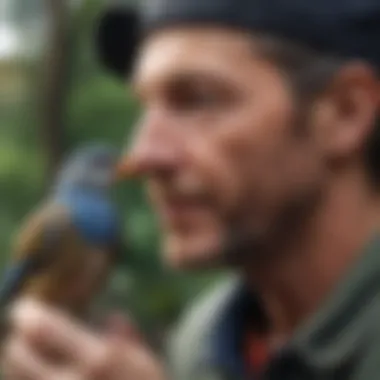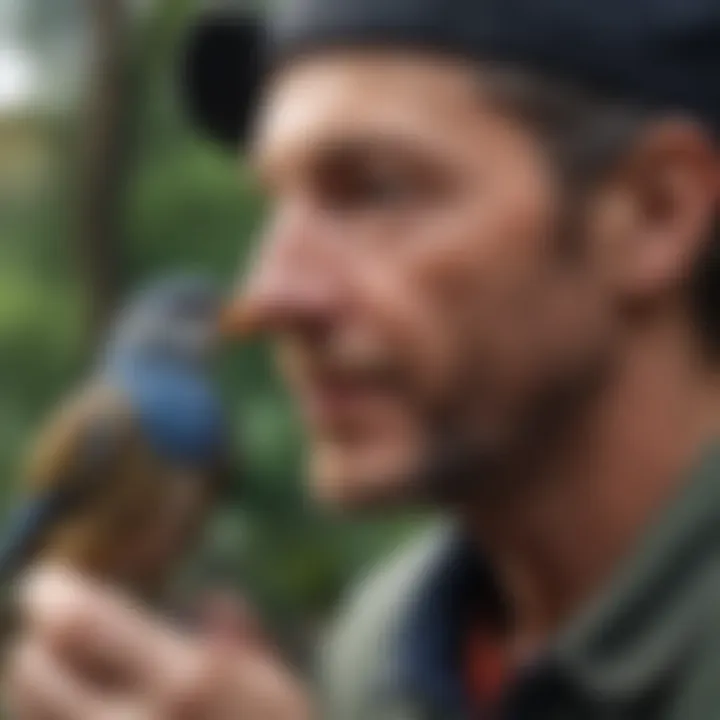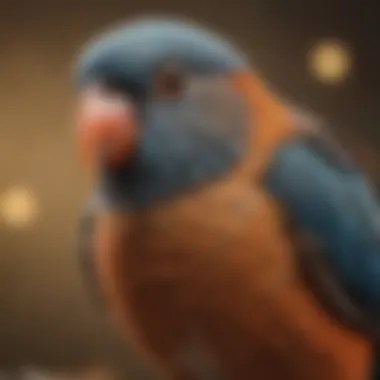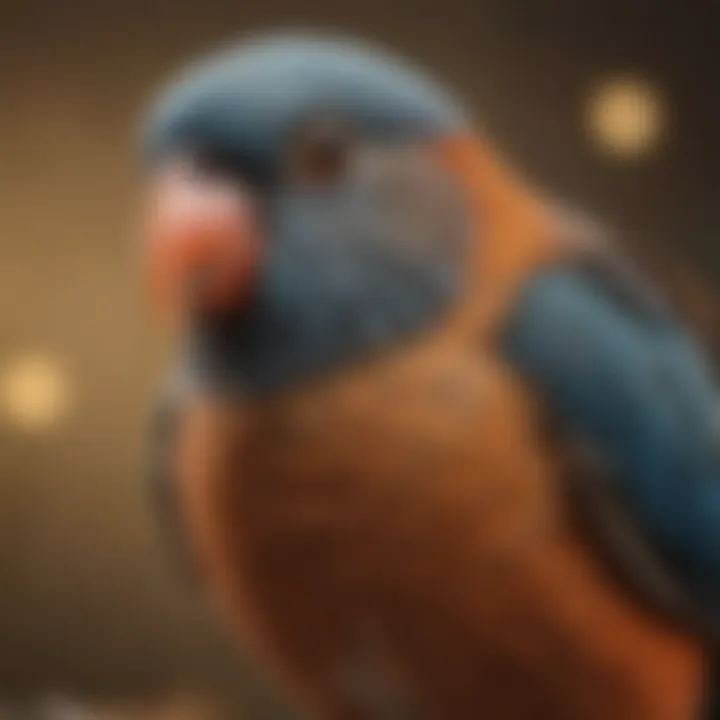Understanding Pet Birds and Their Human Bonds


Intro
When it comes to companionship, few creatures can bond with humans as profoundly as pet birds. Their ability to recognize faces, respond to speech, and even mimic sounds showcases not just intelligence but also an emotional depth that often leaves owners in awe. This article ventures into the intricate relationships formed between humans and various bird species, providing a roadmap for understanding these birds and enriching their lives along with our own.
The bond between human and bird is not just a matter of keeping them fed and housed. Rather, it encompasses daily interaction, understanding their unique communication styles, and recognizing the signs of their emotional needs. This journey into the world of pet birds will reveal practical insights for creating a nurturing environment that promotes deep connections. Let’s explore the facets that go into this beautiful relationship, beginning with the essential care tips that lay the foundation.
Care Tips
Daily Care Routines
To foster a strong bond with your feathered friend, establishing daily routines is crucial. Routine provides security for birds, making them feel safe and comfortable.
- Morning interactions: Start the day by greeting your bird. Spend a few minutes talking to them. This helps them wake up and feel connected.
- Interaction times: Incorporate regular playtime. Birds thrive on social interaction and getting to know you over time enhances your bond.
- Afternoon training sessions: Use portions of the day for light training or tricks, as this not only stimulates their minds but also builds trust.
Cage Setup and Maintenance
A well-maintained cage is the home base for your pet bird. An inviting cage setup encourages exploration and comfort.
- Size Matters: Ensure the cage size fits the species. Larger birds need room to fly, while smaller ones can thrive in more compact spaces.
- Perches: Use varied perch sizes and materials to promote healthy feet. Natural wood is often a good choice.
- Aesthetics: Add colorful toys and safe plants to create an engaging environment. Birds love to explore, and visually stimulating spaces invite curiosity.
Hygiene and Cleaning Practices
Cleanliness directly affects the health of your bird. Regular cleaning is essential to remove waste and prevent illnesses.
- Daily spot cleaning: Remove leftover food and droppings.
- Weekly deep cleaning: Take time to wash toys, bowls, and the cage itself to keep it hygienic.
Seasonal Care Adjustments
Birds have different needs with the changing seasons. Managong these changes can help promote their overall well-being.
- Winter: Keep them warm, ensuring their cage is not near drafts. Using a heated perch might be wise.
- Summer: Provide shade and ample fresh water as they may become more active in warmer weather.
Behavioral Insights
Understanding Bird Body Language
Being observant to your bird's body language can be enlightening. Learning to read these signals can help you respond appropriately to their needs.
- Feathers Fluffed: Indicates comfort, while drooping feathers can signify illness.
- Head Bobbing: A sign of excitement or attention-seeking. Your bird wants to engage!
Common Behavioral Issues and Solutions
Birds, like any pet, can exhibit behavioral issues when unhappy or stressed.
- Feather Plucking: Often a sign of boredom or anxiety. Increasing social interaction or environmental enrichment is key.
- Screaming: While loud calls are normal, incessant screaming might indicate loneliness. Ensure attention is frequent.
Positive Reinforcement Techniques
Creating a positive reinforcement system can do wonders for training efforts and strengthen your bond.
- Use treats sparingly to reward good behavior. Keep a bag of sunflower seeds nearby during training sessions.
- Verbal praise is just as important. Let your bird know they're doing well with positive affirmations.
Social Interaction Needs
Social species like parrots need ample social interaction.
- Daily quality time out of the cage is essential. It allows them to connect and learn more about their environment.
- If you're busy, consider adding an additional bird. Note that each species has different requirements.
Nutrition Guides
Essential Diet Components
A thorough understanding of your bird's nutritional needs can make a big difference in their health.
- Seeds and pellets should form the basis of their diet. Mix in fresh fruits and vegetables to provide essential vitamins.
- Always check for species-specific dietary recommendations as different birds have unique needs.
Safe and Toxic Foods
Not all foods are safe for birds. Knowledge here is critical for their well-being.
- Avoid chocolate, avocado, and caffeine.
- Safe options include apples, carrots, and leafy greens.
Supplements and Treats
Occasional treats can boost your bird's mood. Just remember moderation is key!
- Consider calcium supplements if they are lacking in their diet, especially for laying hens.
Feeding Strategies for Different Species
Each species has unique feeding habits. Tailoring your approach can prove beneficial.
- Budgies enjoy a varied diet and can be given millet sprays as a treat.
- Cockatiels may prefer softer foods and are less inclined towards seed mix.
Wellness and Health
Routine Health Checkups
Regular vet checkups should be part of your details to ensure a long and healthy life.
- Schedule annual visits and check for early signs of illness during the check.


Identifying Symptoms of Illness
Be alert to changes in behavior, such as changes in diet or lethargy, which can indicate health issues.
- Frequent sneezing or changes in droppings often require immediate attention.
Preventative Care and Vaccinations
Vaccinations can help keep your bird healthy.
- Consult your veterinarian about recommended vaccinations suitable for your bird's species.
Mental and Emotional Well-being
Birds need stimulation not just physically but mentally as well.
- Change toys regularly to encourage foraging behaviors and mental engagement.
Enriching Activities
Toys and Playtime Ideas
Toys can turn mundane time into quality bonding. Rotate toys regularly to keep things fresh and engaging.
- Foraging toys stimulate their natural instincts, encouraging activity and curiosity.
Training and Tricks
Training can be a fun interaction that deepens your connection.
- Teaching simple tricks, like step-up commands, can solidify trust.
Outdoor Activities and Interaction
Taking birds outside safely can be thrilling for them and offer fresh perspectives.
- Ensure they are secure in their carrier or on a harness during outings.
DIY Projects for Mental Stimulation
Creativity knows no bounds in engaging birds mentally. You can design various toys or puzzles to challenge them.
- Use safe household items to create unique challenges, such as hiding treats in paper cartons.
"Understanding your bird is as vital as caring for its basic needs." This insight can set the stage for a rewarding relationship that benefits both parties.
This article will continue exploring further dimensions of these fascinating relationships, ultimately guiding you to nurture a lasting bond with your feathered companions.
Preamble to Human-Bird Bonds
Birds have long captured the imagination of humans, their vibrant feathers, melodic songs, and engaging behaviors making them fascinating companions. Delving into the human-bird bond isn't just about observing pretty creatures in a cage; it involves a deeper understanding of how these animals perceive their world and how they connect with us. Why is comprehending this relationship essential? Simply put, it enhances the overall experience for both parties involved.
When pet owners grasp the nuances of their birds’ wants and needs, they foster a stronger and more harmonious relationship. It aids not only in building trust but also in defining roles and establishing routines that make for a cohesive environment. The joy derived from witnessing a bird trust you, seek your company, or simply preen beside you is unparalleled. Each moment spent nurturing this bond contributes to a fulfilling partnership.
The journey begins by recognizing that birds, like us, have their unique personalities. Some are curious and extroverted, while others are reserved and contemplative. Understanding these traits leads to tailored approaches in training and socialization, resulting in a more profound connection.
The Unique Relationship Between Humans and Birds
The relationship that humans form with birds is compelling. It’s not just a lack of fur or scales that sets birds apart; their intelligence plays a significant role in how they interact with us. For instance, a Budgerigar can learn to mimic words, effectively communicating with its owner. This ability often makes pet owners feel as though they're engaging in a genuine dialogue.
Birds exhibit empathy and attachment, much like dogs or cats. They respond to their owners’ moods and often mirror emotions. Whether it’s a change in tone of voice or body language, birds are exceptionally observant. This empathy can foster a sense of companionship, making them feel less like pets and more like family.
Moreover, the daily rituals we share with our birds contribute to the strength of these bonds. Simple actions, such as greeting them in the morning or engaging in play sessions, add layers to the relationship. The rhythm of life that evolves between the two can mirror the complexities of human interactions, rich with emotional depth.
"Birds are not just creatures; they are connections. They weave a fabric of companionship that threads through our hearts."
Popular Pet Bird Species for Bonding
The journey into the world of pet birds unveils a rich tapestry of species known for forming strong human bonds. Selecting the right bird species can be pivotal for those looking to cultivate meaningful relationships with their feathered companions. Different species not only have distinct behavioral traits but also unique needs and preferences. Understanding these nuances enables potential bird owners to choose a pet that complements their lifestyle and personality.
Budgerigars: The Social Nimblers
Budgerigars, commonly called budgies, are small, lively birds that have garnered a reputation for their sociable nature. They can be seen flitting around the aviary, engaging with their fellow companions and their human caretakers alike. Budgies thrive on interaction, making them ideal pets for individuals or families eager to foster a connection.
These birds come with a variety of colors and patterns, which often captivates the hearts of many owners. A notable feature of budgies is their ability to mimic sounds, including human speech. Regular talking and socializing with these birds can encourage chirpy conversations, adding to the bond formed over time.
Budgerigars are not just birds; they are chirpy friends eager to connect with those who take the time to listen and engage.
Cockatiels: The Affectionate Companions
Cockatiels are known for their charming personality and distinctive crest, which they often raise or lower based on their mood. This visual cue invites owners to connect more personally, as it translates their feelings without words. Known for their gentle disposition, cockatiels enjoy snuggling and often seek physical closeness with their owners, a testament to their affectionate nature.
They usually communicate through whistles and soft coos, a delightful part of their allure. For those considering a pet that provides warmth and connection, a cockatiel shines brightly in this realm. With ample positive interactions, they can mimic tunes and phrases, creating a melodic atmosphere that fills a home with joy.
Lovebirds: Intimacy in Flight
Much like their name suggests, lovebirds are celebrated for their deep bonds with their partners, be it another bird or their human caregivers. These small, vibrantly colored birds exemplify companionship, often snuggling with one another or with their owners, displaying profound affection and loyalty.
Lovebirds require plenty of social interaction; a lonely lovebird can become anxious and possibly develop bad habits. Creating a nurturing environment is key to keeping them happy. When well-cared for, they reward their owners with playful antics and heartwarming behaviors that enhance the bond.
African Grey Parrots: The Intellectual Connectors
Renowned for their remarkable intelligence, African Grey parrots often engage in complex interactions with their human companions. Their cognitive abilities make them not only engaging pets but also thoughtful partners. African Greys can learn extensive vocabulary and phrases, reflecting their keen observance of human behavior.


This breed often develops a codependency, greatly affected by their environments and interactions. Ensuring they feel safe and understood will significantly strengthen the bond. Time invested in training and mental stimulation is vital for maintaining their well-being and fostering a deep sense of trust.
Conures: The Playful Spirits
Conures are a diverse group of birds that radiate vibrancy and energy. Their playful nature often leads to joyful interactions, drawing many to consider them as suitable pets. These birds are known for their spontaneous antics, and they usually require stimulation to keep them engaged.
Their social and affectionate character allows them to bond closely with their owners, often expressing affection through nuzzles and playful behavior. Spending quality time playing with toys and learning tricks can significantly enrich their bonds with humans. Conures’ hearty laughter and playfulness can weave a special connection that fills a home with laughter and joy.
Factors Influencing Bonds
When it comes to fostering a profound connection with pet birds, several elements play significant roles in shaping these relationships. Understanding the factors influencing bonds can help bird owners cultivate a supportive and loving environment for their feathered companions. These factors not only enhance the welfare of the birds but also enrich the experiences for the owners, allowing both parties to thrive in their cohabitation.
Early Socialization and Exposure
Socialization is crucial for the development of young birds. The first few weeks of a bird's life are pivotal. Birds that receive proper social exposure to different environments, sounds, and, most importantly, interactions with humans are often more adaptable and confident. In contrast, a lack of this early exposure can lead to timidity and fearfulness.
- Regular Handling: From a young age, handling the bird gently helps it associate human presence with safety. This can range from simple stroking to holding them in one’s hands.
- Variety of Experiences: Introducing your bird to diverse sights, sounds, and textures can foster curiosity and adaptability. For instance, exposing it to different rooms in the house, various visitors, or even sounds from the outside world nurtures resilience.
Setting the groundwork for future interactions, early socialization can dramatically alter how a pet bird navigates its relationship with humans. Birds that embrace social experiences are typically more inclined to bond closely with their owners.
Time Spent with Owners
Time is a fundamental currency in building strong bonds with pet birds. The more time owners dedicate to their birds, the stronger the relationship grows. This is not just about being physically present; it’s about engaging meaningfully during that time.
- Quality Over Quantity: Spending focused, undistracted time with the bird during play or training can have more impact than merely being in the same space. Activities like teaching new tricks or engaging in play with toys can create shared experiences that deepen bonds.
- Consistency: Birds thrive on routine. Regular interaction at the same time each day can signal to the bird that it is valued and loved. Such consistency builds trust, making birds feel more secure in their relationships.
Communication and Interaction Styles
Communication is the heartbeat of any relationship, and this holds true for human-bird bonds. Understanding how to effectively communicate with pet birds greatly influences the development of strong attachments.
- Verbal Cues and Body Language: Birds are adept at picking up on vocal tones and body language. Using a gentle, nurturing voice while maintaining calm body movements fosters security and understanding. For example, when approaching your bird, soft greetings accompanied by slow movements can encourage a positive reaction.
- Encouraging Responses: Positive reinforcement, like offering treats or praise, when a bird responds favorably to your interactions, can create a loop of positive feedback. Birds respond to these cues, making them more inclined to engage in future interactions.
In summary, understanding these factors and tailoring your interactions accordingly can lead to enhanced bonding. Each pet bird is unique, adapting these insights to fit individual needs can unlock deeper connections, paving the way for a mutually enriching relationship.
Understanding Avian Psychology
Understanding avian psychology is central to fostering a solid relationship between pet birds and their human caregivers. This knowledge enables bird owners to navigate the complex world of avian emotions and behavior. Just like humans, birds have their own set of feelings, attachments, and coping mechanisms. By delving deeper into these aspects, bird owners can not only strengthen their bond with their feathered companions but also ensure happier, healthier lives for their pets.
The Role of Trust
Trust serves as a cornerstone in the relationship between humans and birds. For many pet birds, the initial interaction with humans can evoke a range of emotions, from curiosity to fear. Building that trust is not an overnight process; it requires patience, consistency, and a gentle approach. To illustrate this point, consider a parakeet named Jazz. When he was adopted, Jazz was timid and quite hesitant. Over time, his owner learned to understand his body language. Sitting quietly near his cage, offering him treats, and speaking softly helped Jazz realize that not all humans pose a threat. Through these small yet significant interactions, Jazz began to trust his owner, displaying a noticeable shift in his demeanor.
Trust isn't merely about the absence of fear; it’s about feeling secure in one's environment. Birds that feel safe are more likely to express themselves and engage in social behaviors. This is crucial for building a strong bond. Here are a few tips to foster trust:
- Spend quiet time with your bird without overwhelming it.
- Use treats to create positive associations with your presence.
- Always approach your bird calmly and gently to avoid startling it.
As trust develops, it opens the door to deeper emotional connections, paving the way for a fulfilling partnership.
Attachment Styles in Birds
The concept of attachment styles is not limited to humans; birds also exhibit preferences in how they bond, which can impact their relationships with their owners. Understanding these styles is beneficial for anyone looking to nurture a more profound connection with their pet.
Birds often display attachments in various forms, akin to what psychologists refer to as secure, anxious, or avoidant attachments. A secure parrot might actively seek interaction and affection, knowing it has a safe space to return to. In contrast, an avoidant bird may prefer to keep its distance, remaining self-sufficient and apprehensive about engaging too closely with its owner.
For example, let’s take Charlie, a cockatiel who initially exhibited avoidant behavior. He would often fly away whenever someone approached his cage. With time and consistent interaction, Charlie learned that his owner had no intent to harm him. Gradually, he shifted towards a more secure attachment style, seeking affection and preening his owner’s hair—an unmistakable sign of trust and affection.
Factors that influence attachment styles include:
- Early socialization and exposure to various experiences.
- Positive interactions that promote feelings of comfort and security.
- Individual personality traits, which vary from bird to bird.
By cultivating an environment that promotes secure attachment, bird owners can create deeper emotional ties and enhance the overall well-being of their pets.
"A relationship built on trust and understanding allows for genuine connections, turning care into companionship."
Training Techniques to Enhance Bonds
Successfully building a strong bond with pet birds often hinges on the training techniques employed by their caregivers. Understanding these methodologies is crucial for nurturing a connection that transcends mere companionship. By fostering communication and cooperation, training not only helps instill good behavior but also promotes trust and affection, making it the cornerstone of a flourishing human-bird relationship.
There are specific elements to consider when implementing training techniques. First and foremost, consistency is key. Birds thrive in structured environments where they can predict outcomes based on their actions. This predictability fosters a sense of security, ultimately fortifying the bond between bird and owner. It's also important to adjust expectations based on the individual bird's personality and capabilities; what works for a lively cockatiel may not resonate with a more reserved African Grey.
Benefits of employing effective training techniques in nurturing these bonds include:
- Strengthened Trust: Interactive training helps birds understand that their human companions mean well, nurturing feelings of safety and love.
- Enhanced Communication: Birds are instinctively social creatures, and training fosters a two-way communication pathway, making it easier to understand one another.
- Behavioral Improvement: Training can prevent problem behaviors stemming from boredom or stress, leading to a calmer home environment.
When birds partake in training sessions, they are not just learning behaviors; they are engaging in a shared experience that brings them closer to their human companions.
Positive Reinforcement Strategies
Positive reinforcement is a powerful tool in any training regimen. At its core, this strategy hinges on rewarding desired behaviors rather than punishing unwanted ones. This approach aligns seamlessly with avian psychology. Many birds are eager to please and respond enthusiastically to reward-based cues. Choices of rewards can vary widely, from treats like high-quality seeds or bits of fruit to verbal praise or gentle petting—whatever data indicates your bird finds motivating.
Here are some effective techniques you might want to incorporate:
- Timing Matters: Deliver rewards immediately after the desired behavior to create an association in your bird's mind.
- Varied Rewards: Use a mix of treats and praises to keep the learning process engaging.
- Short Sessions: Birds have limited attention spans, so keep training sessions to around 5-10 minutes to avoid frustration.
Adopting positive reinforcement could also encourage exploration and interaction, forging an emotional connection that significantly adds to the bonding experience.
Clicker Training Basics
Clicker training is another method that can help enhance the bond between humans and their pet birds. This technique involves using a small handheld device that makes a distinct sound (the click) to signal a behavior that has been performed correctly. Immediately following the click, a reward is given, reinforcing the connection even further.
To effectively implement clicker training, follow these steps:
- Introduce the Clicker: Start by associating the click sound with a reward without any commands. Just click and treat, allowing the bird to understand the sound equals a reward.
- Teach Basic Commands: Gradually introduce simple commands—things like “step up” or “down”—coupled with the click sound when they comply.
- Increase Complexity: As your bird begins to understand, teach more complex behaviors, ensuring that each new command is paired with clicks and rewards.


By incorporating clicker training, you are not just teaching behaviors but also enhancing the communication channels between you and your feathered friend.
"A well-trained bird is a respected companion, and mutual respect forms the foundation of strong bonds."
Creating a Nurturing Environment
Creating a nurturing environment for pet birds is paramount in fostering a strong bond between them and their humans. This goes beyond simply providing food and water; it's about crafting a space where birds can thrive physically and emotionally. By focusing on the right habitat and enriching activities, owners can significantly enhance their birds' happiness and, consequently, their connection.
Habitat Considerations
A bird's habitat is its safe haven, a place where it can express natural behaviors and feel secure. Several aspect can play into creating the right environment:
- Cage Size and Type: The cage should be spacious enough to allow for safe movement and flight. Particularly for birds like cockatiels and conures, a larger cage means more room to exercise and engage in natural behaviors. A good rule of thumb is to choose a cage that is at least twice as wide as the bird’s wingspan.
- Location of the Cage: Place the cage in a social area of the home where the bird can interact with family members. This helps the bird feel included and lowers the chances of anxiety stemming from isolation.
- Toys and Perches: Incorporate a variety of toys, like chewable blocks and hanging swings, as well as different types of perches. Rotating these items keeps the environment fresh and stimulating, which is vital for mental health.
- Safety and Comfort: Make sure the habitat is free of hazards like toxic plants, drafts, or extreme temperatures. Birds need a consistent, comfortable temperature and humidity in their surroundings.
By paying attention to these details, owners can create a space that feels like home for their feathered friends, making them more likely to trust and bond with humans.
Enrichment Activities to Foster Bonding
Enrichment activities can play a crucial role in deepening the bond between pet birds and their owners. Taking time to engage in these activities can transform routine care into meaningful interaction.
- Social Playtime: Spend time outside the cage engaging the bird in free flight if it is safe. Social play can include tossing toys or playing catch with small balls, which encourages movement and interaction.
- Foraging Opportunities: Birds love to forage, and this instinct can be harnessed to foster bonding. Hiding treats in puzzle toys or around the habitat stimulates their natural instincts to search and discover. This not only keeps them busy but also gives them the satisfaction of a job well done.
- Training Sessions: Regular training sessions, using positive reinforcement techniques, allow for continued learning and bonding. Simple tricks like “step up” or “turn around” can be a fun way to engage. Through consistent practice and rewarding them, owners foster trust and companionship.
- Interactive Time with Music and Sounds: Birds are often known to be curious about music and sounds. Playing gentle music can be pleasing to a bird’s ears. Experimenting with different melodies and observing their reactions can deepen their connection with the owner.
"A nurturing environment filled with engagement not only enhances a bird's happiness but also builds an emotional bridge between the bird and owner."
Each of these activities encourages interaction, trust, and affection. Investing time in these techniques can yield a rewarding relationship, allowing both birds and their owners to thrive together.
By creating an environment that values comfort and engagement, pet owners pave the way for an unforgettable bond with their cherished avian companions. This investment in their happiness translates into stronger, more affectionate relationships.
Signs of a Strong Bond
Understanding the signs of a strong bond between pet birds and their owners enriches the human-bird relationship significantly. These signs are not just mere behaviors but are symbolic of deep trust and affection that birds show towards their humans. Recognizing and interpreting these signs is essential, as it allows owners to nurture and maintain these connections effectively. A solid bond contributes to a bird's overall well-being, reduces stress, and enhances their quality of life. It can also minimize behavioral issues, making for a more harmonious cohabitation.
Behavioral Indicators of Affection
Birds, like humans, express their feelings in various ways. When they feel affection, it’s as if they wear their hearts on their feathers. Here are some common behaviors that indicate a strong bond:
- Proximity: If your bird prefers staying close to you, often seeking you out, that’s a major indicator of affection. Birds are social creatures, and wanting to be near you signifies trust.
- Preening: Grooming is not just a hygiene routine; it’s a bonding activity. When your bird attempts to preen you or allow you to preen them, it shows a deep level of comfort.
- Nuzzling: A gentle nuzzle or rubbing against you is a sign of affection. Birds do this instinctively when they feel safe and loved.
- Relaxed Posture: A bird perched comfortably, with a relaxed stance, often indicates it feels secure in their surroundings. If they lay down or flatten their feathers when close to you, that's a positive sign.
- Mimicking Actions: Birds that mirror your behaviors, such as tilting their heads or moving to your rhythm, signify engagement and interest, deepening their bond with you.
These behaviors, while subtle, speak volumes about the love and trust your avian companion shares with you. Recognizing them not only breeds a sense of appreciation but also strengthens your bond.
Vocalizations and Communication
Birds have their own unique sounds that serve as a verbal language. These vocalizations can range from sweet chirps to loud squawks, and they are essential indicators of your bird's emotional state and affection towards you.
- Chirping: A bird that chirps frequently while interacting with you is often feeling content and secure. Soft, melodic sounds typically show your bird is enjoying your company.
- Whistling: If your feathered friend whistles back at you or mimics tunes you play, this indicates a desire for interaction and affection.
- Talking: Certain species, like African Grey parrots or budgerigars, are known for their ability to mimic human speech. If your bird tries to speak to you or repeats words and phrases, it’s their way of showing attachment and engagement.
- Screaming: While not typically a positive sound, loud screeching can simply mean your bird is excited to see you or wants your attention. It’s crucial to decipher the context of the vocalization.
Paying attention to how your bird communicates can provide insights into their feelings and well-being. Each sound can be a window into their emotional experience, reinforcing the connection you share.
"Being attuned to your bird's behaviors and vocalizations is vital. It makes the bond feel as natural as a sunrise, beautiful and deeply rooted in trust."
Recognizing the signs of a strong bond is a rewarding endeavor for any bird owner. It paves the way for a fulfilling relationship that benefits both parties, ensuring that the affection between you and your pet bird flourishes.
Challenges in Bonding with Birds
Bonding with pet birds can be a rewarding journey, yet it often comes with its fair share of challenges. Understanding these obstacles is crucial for pet owners and bird enthusiasts alike. In this section, we explore some of the key elements that can hinder or complicate the bonding process, offering insights and solutions to foster a more harmonious relationship.
Overcoming Trust Issues
One of the primary hurdles in forming a strong bond with a pet bird is building trust. Unlike dogs or cats, birds can be more skittish and hesitant to engage with humans, often stemming from their instinctual survival mechanisms. Socialization plays a huge role in trust development; birds that have experienced trauma or been poorly socialized may take longer to feel secure.
To encourage trust, patience is paramount. Slow and gentle introductions are essential. Here are some steps you can take to help your bird feel more secure:
- Create a Safe Environment: Make sure the bird's living space is quiet and free from potential threats. A calm atmosphere fosters relaxation and openness.
- Consistent Routine: Establish a daily routine for feeding and interaction. Predictability helps birds to feel more at ease.
- Allow Exploration: Let your bird explore its environment without forcing interactions. This way, the bird can approach you at its own pace.
If a bird shows signs of fear, like puffing up or attempting to escape, it’s important to back off and give it space.
"Trust is the foundation of any meaningful relationship, and with birds, it may take time to build this trust, but the rewards are well worth the effort."
Addressing Behavioral Problems
Sometimes behavioral issues can impede the bonding process. Common problems include biting, excessive screaming, or territorial behavior. Understanding the root of these behaviors is vital for both the bird’s wellbeing and the owner’s comfort.
- Biting: This can happen for many reasons, such as fear or playfulness. Instead of reacting negatively, consider the context. Is your bird trying to communicate or express discomfort? Address it by identifying triggers and gradually desensitizing your bird to certain situations.
- Screaming: While vocalization is natural, excessive noise can be challenging. Ensure your bird is not bored or seeking attention unnecessarily. Engagement through toys and social interaction can reduce this behavior.
- Territorialism: Birds can become possessive over their cages or favorite perches. Training them with positive reinforcement to associate you with pleasant experiences can help mitigate this.
The Role of Routine in Bonding
Routine plays a pivotal role in cementing the companionship between humans and their pet birds. Establishing a consistent pattern of interaction not only enhances the relationship but also contributes significantly to the well-being of our feathered friends. Birds, by their very nature, thrive on predictability. When they know what to expect, it helps them feel secure and fosters a deeper connection with their owners. The comfort of routine provides a framework within which a bond can flourish.
Building Consistency in Interaction
When pet birds experience regular interactions, it leads to a sense of stability and trust. Here are some key elements that illustrate why consistency matters in bonding with these intelligent creatures:
- Predictability: Birds, especially species known for forming strong bonds, benefit from knowing when they will interact with their owner. Whether it’s a morning cuddle or an evening training session, these predictable moments provide them with a sense of safety.
- Reinforcement of Behaviors: Repeating interactions can reinforce positive behaviors. For instance, if a bird learns that stepping onto a finger leads to treats during specific times of the day, its willingness to do so will likely grow. Consistency in rewards and interactions is vital for training and strengthening the bond.
- Shared Activities: Setting a routine that includes enjoyable activities—like scheduled playtime or targeted training sessions—can create communal moments that age with appreciation. Birds often respond positively to engagement when they know it’s coming.
- Emotional Security: An established routine helps in curbing anxiety in birds, particularly during disturbances such as loud noises from the outside or changes in household dynamics. Knowing that their human is a steadfast presence can help ease any distress they may feel from external factors.
To illustrate this point further, consider a scenario where a budgerigar, who expects its owner to greet it every evening, begins to anticipate the joy that follows the set interaction. Such consistent engagement cultivates not just trust but affection as their companionship grows.
"Routine is not a cage, but a framework that fosters trust and affection, providing a steady beat in the symphony of human-bird interactions."
In summary, creating a routine for your pet bird is not merely a suggestion but a strategy that vastly improves how these intelligent creatures relate to their human companions. By setting aside dedicated time for interaction, be it through talking, training, or playing, owners can lay down the groundwork for a bond that is both enriching and enduring. Routine should be seen as a pathway to creating secure environments where both the bird and the owner can thrive.
Ending
Understanding the intricate world of human-bird relationships is crucial for pet bird owners and anyone interested in these fascinating companions. This discussion sheds light on the many aspects that contribute to forming strong bonds with our feathered friends. As we dive into the specifics, several critical elements emerge:
- Nurturing Environments: Creating an atmosphere that enables comfort and exploration is essential. Birds, much like humans, thrive in places where they feel secure and stimulated. Providing a suitable habitat — one that mimics their natural environment — allows them to express their instincts and reduces stress, which is vital for bonding.
- Communication and Interaction: Birds possess rich ways to communicate, often much more complex than we assume. Paying attention to their vocalizations and body language can significantly enhance the bond. Engaging in regular interactions fosters familiarity, which leads to a deeper connection.
- Routine and Consistency: Establishing a daily schedule not only comforts birds but also allows them to anticipate interactions with their owners. This predictability strengthens trust over time, as birds learn what to expect from their human companions. A consistent routine can include feeding, playtime, and training, all contributing to the overall relationship.
- Respecting Individuality: Each bird is unique, and owners should approach bonding with an understanding of their pet's specific traits, preferences, and sometimes even quirks. Some birds may prefer gentle interactions, while others might thrive on playful engagement. Recognizing these differences is paramount in fostering a relationship built on mutual respect and understanding.
- Addressing Challenges: Issues such as fear or behavioral problems can appear as significant roadblocks in bonding. However, each challenge presents an opportunity for learning and growth, both for the bird and the owner. Approaching these situations with a patient mindset can yield positive outcomes, reinforcing the bond over time.
"Birds require patience, love, and understanding. As they blossom, so too does the relationship with their keeper."
In summary, cherishing the unique connection between humans and birds involves a commitment to nurture the relationship through understanding, engagement, and consistency. With this article, pet bird enthusiasts are better equipped to recognize the depth of these connections, paving the way for enriching companionships that benefit both parties. By investing time and care into these incredible creatures, we ultimately enhance our lives, as well as theirs.















